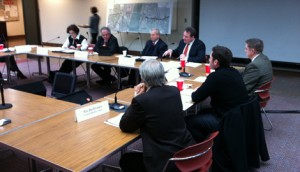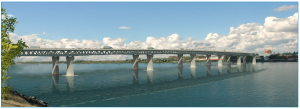The Columbia River Crossing Light Rail project (CRC) has officially entered its “pre-construction” phase, even though planners have yet to secure a penny of the estimated $10 billion* they will need to fund capital costs.
The announcement came Thursday during the final meeting of the CRC Project Sponsors Council, a 10-member oversight committee comprised of elected officials, state transportation leaders, and two citizen co-chairs. The council included Vancouver City Council member Jeanne Harris, Vancouver Mayor Tim Leavitt, Clark County Commissioner Steve Stuart, and attorney Steve Horenstein, the council co-chair.Although Leavitt is the mayor of Vancouver, according to the CRC website he does not represent the city on this committee. Harris represents the city. Leavitt represents the C-Tran board of directors. Likewise, Stuart did not appear as a representative of the Clark County Commissioners, but rather the SW Washington Regional Transportation Council board. The City of Portland is represented by Sam Adams, who was absent.
The group, which originally convened in 2008, had plans to meet until the project’s Final Environmental Impact Statement (FEIS) received a federal record of decision. That decision occurred Dec. 7.
With the FEIS milestone in the past, the discussion of Thursday’s meeting focused on convening new groups that would focus on the next phase in planning and funding. The CRC project is a massive effort that will include a 10-lane replacement bridge for the current Interstate Bridge spans, reconstruction of five major highway interchanges, and the extension of light rail from Portland to Vancouver. Construction is expected to stretch eight years from 2013 to 2021.

Project Sponsors Council met to discuss CRC funding, lawsuits and next committee. Pictured (clockwise): Paula Hammond, Steve Horenstein, Henry Hewitt, Matt Garrett, Kris Strickler, Tim Leavitt, Rex Burkholder.
To fund the project, CRC planners hope to land $850 million in federal New Starts funds to build the light rail line, $400 million in federal discretionary highway funds, $900 million in state funds split evenly between Oregon and Washington, and as much as $1.2 billion in state-backed bonds and/or federal TIFIA loans that will be paid for through tolling.
“We need to put together a plan to leverage as many sources as we can,” said CRC Director Nancy Boyd to the council. “Our intent is to be very competitive for federal funds. There are lots of hoops to jump through.”
Washington Department of Transportation’s federal relations manager Allison Camden gave a rosy update to the council regarding efforts in Washington D.C. to increase federal highway dollars, even though competition between national projects will be strong.
Camden said the budget for the New Starts program has increased, and both Washington and Oregon Congressional delegations are pushing for the continuation of the federal Projects of National and Regional Significant (PNRS) program, a key highway fund the CRC hopes to qualify for.
“It means good things for us in the pipeline,” Camden said.
Lawsuits won’t necessarily slow down momentum
C-Tran Board representative Leavitt broached the topic of how potential lawsuits against the CRC’s FEIS might impact the project.
Washington State Secretary of Transportation and council member Paula Hammond said a legal challenge wouldn’t have to hold up construction. She was confident the CRC carefully followed the NEPA process in preparing the FEIS and also said state attorneys are well prepared to handle any lawsuit.
“We haven’t lost one yet,” Hammond said.
Horenstein, however, was a bit more cautious, saying that if there were a major lawsuit, he might hesitate breaking ground too quickly.
“We would think twice about constructing,” he said.
New jobs, no guarantees
Commissioner Stewart asked what assurances the CRC could give that it would hire local contractors once construction began. CRC staff predicts that construction will lead to 1,900 direct and indirect jobs annually.
“Can we be sure that 1,900 jobs can come from this region?” Stuart asked.
Hammond said a federal project such as this can’t be exclusive when accepting bids, but that every effort would be made to engage local small and minority-owned businesses in the bidding process.
Stuart then reiterated the concern voiced by the SW Washington Regional Transportation Council (SWRTC) – one of six signatory agencies that approved the FEIS – that if fewer federal funds than necessary are available, the financial burden wouldn’t be passed on through tolls.
“Don’t raise tolls to make up the difference,” Stuart said.
New committee created, but opponents not invited
Given that the Project Sponsors Council is disbanding, a committee comprised of project sponsor staff will oversee the detailed planning ahead. The team will include Nancy Boyd and Deputy CRC Director Kris Strickler, along with staff representing the Ports of Portland and Vancouver, Metro, SWRTC, the Oregon and Washington Departments of Transportations, C-Tran, and the cities of Portland and Vancouver.
Horenstein – who represents the WSU-Vancouver Advisory Council and is a board member of Vancouver National Trust – will continue to be cho-chair along with Portland attorney Henry Hewitt, past chair of the Oregon Transportation Commission.
Horenstein proceeded to announce the creation of a Bi-State Citizen Advisory Committee of 30 citizens who will address “on-the-ground” issues related to implementing the current plan, as well as a separate Bridge Design Committee that will work directly with the CRC architect on more technical issues.
CRC spokesperson Anne Pressentin said CRC staff has made great effort through phone calls, e-mails, and press releases to invite citizens from Portland and Vancouver who live within the impact area to submit applications to be considered for the committees. The meetings will be open to the public with public comment welcomed.
Ultimately, however, Horenstein, Hewitt, Boyd, and Strickler will make the final committee selections. Pressentin expects that decision soon.
“The value of that citizen committee is not just the meetings…but we also want those members to go out and talk to folks who may not have time or maybe not have ever been involved in this type of public meeting before,” she said.
Asked whether the citizens invited will represent a spectrum of opinion, Pressentin said committee members must understand that the environmental process is over and the project is moving forward. In other words, naysayers who want nothing more than to stop the project or promote their own preferred alternatives won’t likely get a seat at the table.
“We’re not going to go back to the drawing board,” she said.
* The well-documented cost to taxpayers, if the CRC stays on budget, is $10 billion. This was established by the Cortright Report (PDF) which used data from an independent review panel hired by the governors of Washington and Oregon. (View the panel’s final report.)
See our continuing coverage of the Columbia River Crossing Light Rail project.
Do you have information to share on the CRC? To respond anonymously call 260-816-1426. To allow your comments to be used on COUV.COM call 260-816-1429.










